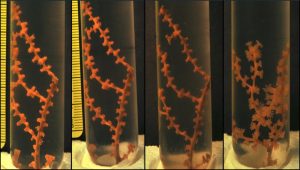Dispersant Used To Clean Deepwater Horizon Spill More Toxic To Corals Than The Oil
– April 10, 2015
The dispersant used to remediate the 2010 Deepwater Horizon oil spill in the Gulf of Mexico is more toxic to cold-water corals than the spilled oil, according to a study conducted at Temple University.
(From (e) Science News) — The study comes on the eve of the spill’s fifth anniversary, April 20th. In this collaborative study between researchers from Temple and the Pennsylvania State University, the researchers exposed three cold-water coral species from the Gulf to various concentrations of the dispersant and oil from the Deepwater Horizon well. They found that the dispersant is toxic to the corals at lower concentrations than the oil.
The researchers’ findings, “Response of deep-water corals to oil and chemical dispersant exposure,” were published online in the journal Deep-Sea Research II.
Approximately five million barrels of crude oil escaped from the well drilled by the Deepwater Horizon oil rig in 2010, and nearly seven million liters of dispersants — chemical emulsifiers used to break down the oil — were used to clean it up. Normally applied to the water’s surface, the spill marked the first time that dispersants were applied at depth during an oil spill.
“Applying the dispersants at depth was a grand experiment being conducted in real-time,” said Erik Cordes, associate professor of biology at Temple, who has been studying Gulf of Mexico coral communities for more than a decade. “It was a desire to immediately do something about the oil coming out of the well, but they really didn’t know what was going to happen as a result.”
Read the full article here: http://esciencenews.com/articles/2015/04/09/dispersant.used.clean.deepwater.horizon.spill.more.toxic.corals.oil
GoMRI “In the news” is a reposting of articles about GoMRI-funded research (published by various news outlets). The author’s interpretations and opinions expressed in these articles is not necessarily that of GoMRI.






